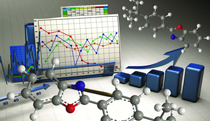Multivariate Regression Modelling of Antifungal Activity of Some Benzoxazole and Oxazolo[4,5-b]pyridine Derivatives
Keywords:
QSAR analysis, Principal component regression, Partial least squares, Candida albicans, Heterocyclic compounds.Abstract
In the present study, principal component analysis (PCA) followed by principal component regression (PCR) and partial least squares (PLS) method was applied in order to identify the most important in silico molecular descriptors and quantify their influence on antifungal activity (expressed as minimal inhibitory concentration) of selected benzoxazole and oxazolo[4,5-b]pyridine derivatives against Candida albicans. PLS regression showed the best statistical performance, according to the lowest value of the standard error (root mean square errors of calibration of 0.02526 and cross-validation of 0.04533), while PCR model was characterized by root mean square errors of calibration of 0.03176 and crossvalidation of 0.05661. The most important descriptors in both PLS and PCR model are solubility in water, expressed as AClogS and ABlogS, and lipophilicity, expressed as XlogP2 and ABlogP. Very good predictive ability of the established models, confirmed by corresponding statistical parameters, allows us to estimate antifungal activity of structurally similar compounds.

Downloads
Published
Issue
Section
License
Except where otherwise noted, articles in this journal are published under the Creative Commons Attribution 4.0 International License
